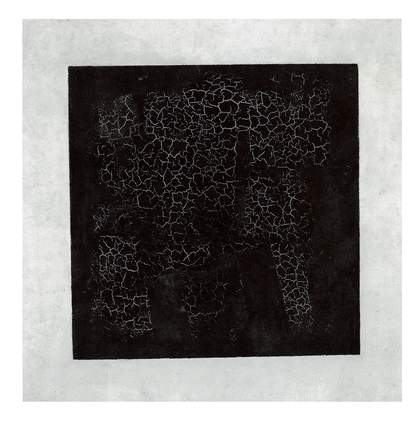We talk of colours as if they were physical fixtures in our daily lives. We say they can be cold or warm, though in doing so we draw on an ad hoc mix of vague metaphors. In his book on colour theory that appeared in 1810, Goethe studied the psychological effect of colours. He called colour “troubled light”, and there is a no more troubling – yet fascinating – colour than black. Could it even be called a colour? Goethe was not so sure. We see black as a surface that absorbs all the colours of the visible spectrum. And it has always had a special aura of its own. It has also had a major influence on artists. Piet Mondrian, who admired Goethe’s theories, used black to great effect in his abstract compositions of horizontal and vertical axes. Here the lines were a structural, architectural framework. For him, it was a “non-colour”. Ad Reinhardt, who made a close study of Mondrian’s work, took this position further when he said: “Black is negation.”He saw it as the negation of all colours, the colour of pure negativity, the representation of the impossibility of representation. The classic example of this is his series of “black paintings”, which rather than reflect a progressive modernism, gave way to a more mystical, contemplative stasis.
The mysterious side to black has appealed to artists. For Paul Klee it was not to be rationalised: “We do not have to understand the black, it is the primeval ground.” His comment recognised the archaic origins of black – back to the time when man had neither tamed fire nor used it to lighten the hours of darkness. One is reminded of the opening sequence of Stanley Kubrick’s 2001: A Space Odyssey (1968), in which the enigmatic black monolith appears unexpectedly in the early days of humankind, and of the night that follows which induces overwhelming fear and existential uncertainty in the apes. Does black actually tap into our brain stem; is it part of our evolutionary experience? For all the progress in neurological research, there is still no answer. All we know for certain is that in our collective consciousness it can evoke a sense of helpless vulnerability.We talk of the Black Death, the black market and blackmail. It often connects to irrational things or those that refuse to submit to any system of cultural certainties.
So you could say that black is subversive, in that it undermines the status quo. In his Philosophical Enquiry into the Origin of our Ideas of the Sublime and Beautiful (1756), Edmund Burke suggests that it is connected both with the terrible and the sublime. His sensualist aesthetic exerted a considerable influence on future generations, such as the American Abstract Expressionists in New York in the late 1940s and Barnett Newman in particular. His atmospherically black Prometheus Bound 1952 is the last in a series of four paintings. The first three, from 1951 – Day before One, Day One and Ulysses – are all presented in the same format as Prometheus Bound. The first and third are in dark blues, Day One is in red, and all three are signed and dated. Prometheus Bound, on the other hand, is not signed. The year before he made this painting, he had had his second one-man show in New York. It met with an extremely poor reception that wounded the artist. Even fellow members of the avant-garde and otherwise loyal colleagues turned their backs on him. The traumatic experience ushered in Newman’s “blackest years”, as he later called them. During that time he withdrew completely from the art world and even considered abandoning his career. In addition, he suffered a near fatal heart attack. Prometheus Bound, a painter’s meditation on the trauma of being shut out, is Newman’s negative self-glorification, an abstract allegorical portrait of his own artistic fate. It was to be seven long years before he found a way out. He had to wait until the late 1950s for a new generation of painters to emerge who were able to understand his work for what it was. The young Frank Stella, for instance, regarded Newman’s creations as the immediate precursors of his own famous pin-stripe paintings.
Black has repeatedly been associated with solid and geometric forms. The best known example dates back to the early seventeenth century in a page within volume one of Robert Fludd’s Utriusque cosmi maioris scilicet et minoris metaphysica (1617). The image – a black square – is presented in the context of a metaphysical iconography of the infinite. Each of the four sides of the square (slightly distorted so that it looks more like a rhombus) is marked with the same words: “Et sic in infinitum.” For Fludd, this image was nothing less than a representation of the prima materia, the beginning of all creation.

Kasimir Malevich
Black Square on a White Ground 1914–15
Oil on linen
80 x 80 cm
© State Tretyakov Gallery, Moscow
Kasimir Malevich’s Black Square on a White Ground, painted almost 300 years later in 1914–15, seems like a distant echo of Fludd’s pictorial creation myth. In Malevich’s canvas the pictorial space, perspective and any sense of illusion are eradicated to leave just the pure black plane. This Suprematist picture, which was to become an icon of modernism, in turn provided the springboard for Ad Reinhardt’s geometric black paintings.
Behind these traditions of radical non-representationalism, these celebrations of iconoclasm, we can detect a sense of melancholy that runs through the works. This mysterious sentiment has a connection with black that dates back to Aristotle – in the Greek language the roots of the word melancholy literally mean black bile. Following in Aristotle’s footsteps many centuries later, Robert Burton, whose low spirits held him hostage in Oxford, adopted the pseudonym Democritus Junior when he published his treatise The Anatomy of Melancholy in 1621. An investigation into the state of melancholy, its history, causes and potential remedies, it was a huge literary success – reprinted and enlarged five times during his lifetime and once posthumously. The above-mentioned celebrations of iconoclasm were not, however, always received without complaint, and conservative cultural critics repeatedly targeted the entirely black page in the first chapter of Laurence Sterne’s The Life and Opinions of Tristram Shandy, Gentleman (1759–67), which is accompanied by the text: “Alas, poor YORICK!”
In the nineteenth century, the colour black featured in very different contexts. Crucial to its role was the response to the work of Velázquez by two very different artists, Goya and Manet. For Goya, black is the vehicle for a radical negativity in the social universe – you just have to look at his copious images of death and disaster. In Manet’s case, it often serves to highlight the self-referentiality and autonomy of painting. This was to be of ground-breaking importance for the course of modernism – a good example being Henri Matisse’s French Window at Collioure (painted, incidentally, in the same year as Malevich’s black square). It draws the viewer’s gaze through the atmospherically differentiated centre section of the painting to a darkened balcony scene. Matisse was the master of autonomous colours who instigated an important art historical shift with his text Black is a Colour (1946), where he writes:
Black is a force: I depend on black to simplify the construction… The Orientals made use of black as a colour, notably the Japanese in their prints. Closer to us, I recall a painting by Manet in which the velvet jacket of a young man with a straw hat is also expressed by a blunt, lucid black. Doesn’t my painting of the Marocains use a grand black which is as luminous as the other colours in the painting?

Frank Stella
From Black Series II 1967
Lithograph on paper
38.1 x 55.9 cm
© Tate © ARS, NY and DACS, London 2006
In other words, Matisse is at pains to release black from its generally accepted identity as a purely absorbent colour, and to establish it as a radiant one with a luminescent quality. This is a reversal of the approach taken by the Impressionists, who, with their predominant interest in light, largely ignored it. Kandinsky, who also liked using black lines in his work, regarded black as leading an existence somewhere away from the “life of simple colour”, which he described either as a circular structure or in terms of its various polarities – yellow/blue, red/green and violet/orange.

Jenny Holzer
Black Garden 1994
Städtische Galerie, Nordhorn, Germany © 2006 Jenny Holzer/ARS, NY and DACS, London
More recently, there has been increasing and eclectic interest in black. In some cases it has alluded to social and political changes. Jenny Holzer’s Black Garden, a permanent installation she made for the Städtische Galerie, Nordhorn, Germany, in 1994, was created, as Holzer has said, as an “anti-memorial” which featured “black or very dark red plants”. It could be interpreted as the death of a world utopian view – a melancholic reworking of Poussin’s painting Et in Arcadia ego, where Death is also present in Arcadia – even at home in the utopia of a life beyond negativity.
If Holzer’s garden makes subtle references to a historical narrative of the meaning of landscape, a more visually rudimentary approach can be seen in Matt Calderwood’s Tape 2004. In this video piece we see a glowing light bulb which is slowly being wrapped with black masking tape until the screen is plunged into total darkness. Here is one of the truly primal instances of a melancholic experience – a solar eclipse transposed into the realms of everyday life. Whereas Calderwood’s use of blackness could be seen as a modern parallel to all those godly Romantic paintings of sunsets, Richard Serra has consistently sought to secularise black, shifting its meaning from a mythical colour to a substantial, physically present paint, so that its optical characteristics seem less important than its tactile qualities, and we begin to sense its gravitational nature (black is heavier than orange).
Sometimes black can evoke a very personal response. In my own case it relates to my acquaintanceship with the great art critic David Sylvester (1924–2001), who I was fortunate enough to meet in the early 1990s. Several years later I learned of his death through an in memoriam piece in Tate Magazine. The text was a wonderful interview with Tim Marlow on the subject of Francis Bacon and included a black-and-white photograph of David, with that uniquely serious, penetrating gaze. On the opposite page – quite by chance – was a reproduction of Jeremy Deller’s I Love Melancholy 2000. When I had finished reading it, it was as though I could still hear his deep voice resonating with echoes of our conversations that revolved, above all, around the work of Barnett Newman. He once told me that Newman, who he knew very well and greatly admired, had been an “ironic tragedian”, whereas he regarded himself as a “vital melancholic”, for, as he put it, he had “something of an erotic relationship” to melancholy. To me, Deller’s image felt like a modern reworking of Nietzsche’s Amor fati, with which he postulates an unconditional love of fate. It is also an image in which we can enjoy plenty of other interpretations. I felt drawn to remembering the last page of W.G. Sebald’s book The Rings of Saturn (1995), where he remarks that in seventeenth century Holland “it was customary, in a home where there had been a death, to drape black mourning ribbons over all the mirrors and all canvases depicting landscapes or people or the fruits of the field, so that the soul, as it left the body, would not be distracted on its final journey, either by a reflection of itself or by a last glimpse of the land now being lost for ever”.



